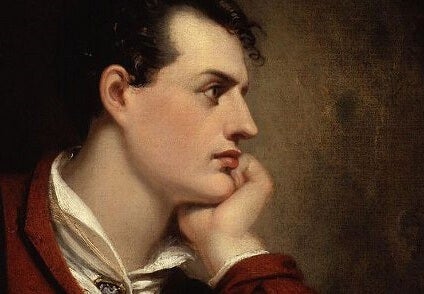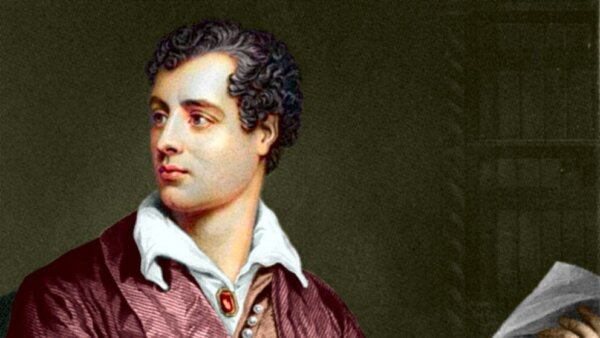Lord Byron: Biography of a Quintessential Romantic


Written and verified by the psychologist Valeria Sabater
Lord Byron embodied the quintessential romantic character. He was the enfant terrible of the 19th century. Hedonist, defiant towards social conventions, brave, eccentric, and, above all, one of the most outstanding poets in history. Few figures have embodied so well that connection between tragic and heroic, a fact that turned him into a true legend.
About ten years ago, a little treasure about George Gordon Byron (his real name) appeared on the scene. His personal diaries were published and we were able to get to know him better. These personal notes offer us some very revealing information about his person (not his character).
In these pages full of his personal writings, people discovered a young man who had little to do with that image of a Casanova who was famous for his love affairs.
From the pages of his diary
We discovered that he did indeed love his half-sister. However, all the romances attributed to him with Shelley or Polidori, for example, were never true. He had an admirable artistic sensibility.
Yes, he did indeed have a cynical, brazen, and even contradictory personality. However, he was a man who described himself as a mere observer of the world. Of a world that was too boring (according to him), but in which he lived a life of absolute passion.
Also, he mentioned that he had no political ideas. However, he left his life in England to go and fight for Greek independence and became quite a revolutionary. As we delve deeper into his diaries and his true personality, it helps us, without a doubt, to go beyond the classic image of Byron dressed as a pirate, attracting women like a magnet, and a lover of scandal and adventure.
Thus, in the words of Anthony Burgess, the world still owes Lord Byron a lot. One must go beyond the legend to understand the impact of his work, and, thus, reveal the man behind the mask.
“The great object of life is Sensation – to feel that we exist – even though in pain. It is this “craving void” which drives us to gaming – to battle – to travel – to intemperate but keenly felt pursuits of every description whose principal attraction is the agitation inseparable from their accomplishment.”
-Lord Byron to Annabella Milbanke, his future wife, September 6, 1813-

George Gordon, Lord Byron: biography of a romantic poet
Byron’s father was a famous captain known as Mad Jack. He was infamous for his bad reputation and, above all, his tendency to squander fortunes. In fact, that’s what happened when he married Lady Catherine Gordon, a Scottish heiress. After George Gordon Byron’s birth in Scotland in 1788, mother and son had no choice but to live in humble lodgings in Aberdeen.
Little George was born with a deformity in his right foot, which produced the classic limp he was known for.
At 10 years of age, he and his mother’s luck started to improve. He inherited the title and properties from his great uncle William, the fifth Baron of the Byrons.
From that moment on, his life turned 180 degrees. He went to Harrow, one of the most prestigious schools in England. In 1803, he fell in love with one of his cousins, Mary Chaworth, an older girl who was already engaged.
Her rejection of him and the idea of unattainable love inspired his first poems, which would later continue maturing through each experience and adventure.
University life and the birth of the legend
In 1805, Lord Byron entered Trinity College in Cambridge. It didn’t take long for him to emerge as one of the brightest, yet most extravagant students. His poetry began to gain notoriety among the academic and student community. So did his behavior. His extravagant clothes caught his eye, as well as his pet monkey who went everywhere with him.
He learned boxing, fencing, made great friendships, and finally left his studies after falling in love with a prostitute. He lived in Piccadilly for a while and then returned to his mother’s house, and decided to devote himself to writing poetry. His first published work was Hours of Idleness, in 1807. This work earned him quite unexpected recognition.
In 1809, Byron took a seat in the House of Lords. It was a position of responsibility that he clearly took advantage of, and subsequently embarked on a major world tour with a friend. They went to Lisbon, crossed Spain, and, later, spent a few months in Malta and Greece.
That adventure would end in Constantinople (now Istanbul, Turkey). It was an evocative journey that inspired Byron greatly.

On his return from that long journey, young Byron returned home to discover two major events had occurred. The first was the death of his mother. The second was that his book Childe Harold’s Pilgrimage was a success and he was suddenly the most famous figure in England.
Love and friendship
In the summer of 1813, a lot of people were aware of Byron’s relationship with his half-sister Augusta Leigh. She was the daughter of his father’s first marriage and the person he irrevocably loved all his life. It didn’t matter that she was married: the bond between the two was common knowledge to most.
This burden of conscience appeared in several of his works such as The Giaour (1813), The Bride of Abydos (1813), The Corsair (1814), and Lara (1814). So, in order to break off that relationship once and for all, he decided to marry Annabella Milbanke. He had his daughter Augusta Ada with her, who later became the famous programmer and mathematician Ada Lovelace.
That marriage was short-lived and was pretty much doomed to failure almost from the start. Rumors of Lord Byron’s relationship with his half-sister never ceased to haunt them. Thus, after a well-agreed separation, he decided to leave England and settle in Geneva, near his friend Percy Bysshe Shelley and Mary Godwin (later Mary Shelley). During those months, an intense literary and poetic collaboration emerged that, without a doubt, influenced these three great authors deeply.

Don Juan and the Independence of Greece
After leaving Switzerland, Lord Byron undertook new journeys throughout Italy. He took advantage of this journey, which lasted from 1817 to 1821, to write his greatest poem, Don Juan, a satire in a picaresque style.
In it, he revealed other aspects of his character and personality little known to date: his satirical wit. It’s a daring, comic, and often brash piece of work, in which he left the classic image of the seducer in question.
In 1822, Byron received what were perhaps the most terrible blows of his life. Firstly, his daughter Allegra, five, who he had left at a school near Ravenna, tragically died. Three months later, during a boat trip, his friend Shelley died when his little schooner sank. Ironically, the schooner was called Don Juan.
Fighting for Greece
One year after those losses, Lord Byron was appointed to the London Committee for the Independence of Greece. A company he didn’t hesitate to join in order to fight for a land he loved.
He wasn’t afraid of fighting, and, as if he were a Greek, he went with the same passion and pride to free it from the Ottoman Empire. He was received as a hero and also wrote what was his last composition: On this Day I Complete My Thirty-Sixth Year.
People say that he himself predicted his own death months earlier. While preparing an attack on the Turkish fortress in the Gulf of Corinth with his guerrillas, he fell ill. There was talk of malaria, and also of an epileptic seizure. However, biographers point out that the main cause of his death was poor medical treatment for his terrible bleeding and consequent sepsis.
The quintessential romantic hero died, but not without penning his final wish. His heart would stay in Greece. However, his body was sent back to England, preserved in a brandy barrel. And this is how this romantic and tragic hero left his mark on history.
All cited sources were thoroughly reviewed by our team to ensure their quality, reliability, currency, and validity. The bibliography of this article was considered reliable and of academic or scientific accuracy.
- Byron, Lord (2008) Diarios. Alamut Ediciones
- Nicolson, Harold (2007). Byron, el último viaje. Madrid: Editorial Siruela
This text is provided for informational purposes only and does not replace consultation with a professional. If in doubt, consult your specialist.








